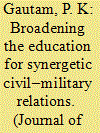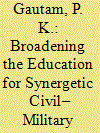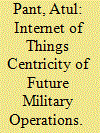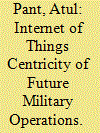|
|
|
Sort Order |
|
|
|
Items / Page
|
|
|
|
|
|
|
| Srl | Item |
| 1 |
ID:
166051


|
|
|
|
|
| Summary/Abstract |
Statecraft, diplomacy and warfare are not only a matter of brute force, but also a function of scholarship to understand the past, present and future of the art, science and literature of national and international security. At higher levels in their professional career, besides the armed forces, a number of civil servants too have to deal with the state’s use or threat of the use of legitimate force. This article suggests broadening the education for synergetic civil–military relations (CMR). This education needs to be imparted, and sustained, in the military as well as in the civil domain, including in particular the political leadership, bureaucracy, and the academic community. By doing this, a healthy CMR will generate superior strategies.
|
|
|
|
|
|
|
|
|
|
|
|
|
|
|
|
| 2 |
ID:
168099


|
|
|
|
|
| Summary/Abstract |
Statecraft, diplomacy and warfare are not only a matter of brute force, but also a function of scholarship to understand the past, present and future of the art, science and literature of national and international security. At higher levels in their professional career, besides the armed forces, a number of civil servants too have to deal with the state’s use or threat of the use of legitimate force. This article suggests broadening the education for synergetic civil–military relations (CMR). This education needs to be imparted, and sustained, in the military as well as in the civil domain, including in particular the political leadership, bureaucracy, and the academic community. By doing this, a healthy CMR will generate superior strategies.
|
|
|
|
|
|
|
|
|
|
|
|
|
|
|
|
| 3 |
ID:
166053


|
|
|
|
|
| Summary/Abstract |
ince the time of their invention and the first-and-only use on 6 and 9 August 1945 on two Japanese cities, Hiroshima and Nagasaki respectively, nuclear weapons have been seen by the states that possess them, or the ones that seek them, as the ultimate guarantors of their security.1 It is believed that these weapons are key to achieving victory in a war that otherwise may go on for a long time or may end in defeat if fought in conventional ways by a weaker country; in other words, nuclear weapons are believed to act as instruments of deterrence. The surrender of Imperial Japan to the Allies after the dropping of atom bomb is referred as the most important case. Some countries tend(ed) to follow the United States (US) path for having the ‘winnable weapons’ that made it to emerge as victorious and super power at the end of World War II.
|
|
|
|
|
|
|
|
|
|
|
|
|
|
|
|
| 4 |
ID:
168101


|
|
|
|
|
| Summary/Abstract |
ince the time of their invention and the first-and-only use on 6 and 9 August 1945 on two Japanese cities, Hiroshima and Nagasaki respectively, nuclear weapons have been seen by the states that possess them, or the ones that seek them, as the ultimate guarantors of their security.1 It is believed that these weapons are key to achieving victory in a war that otherwise may go on for a long time or may end in defeat if fought in conventional ways by a weaker country; in other words, nuclear weapons are believed to act as instruments of deterrence. The surrender of Imperial Japan to the Allies after the dropping of atom bomb is referred as the most important case. Some countries tend(ed) to follow the United States (US) path for having the ‘winnable weapons’ that made it to emerge as victorious and super power at the end of World War II.
|
|
|
|
|
|
|
|
|
|
|
|
|
|
|
|
| 5 |
ID:
168100


|
|
|
|
|
| Summary/Abstract |
Since the last decade of the twentieth century, network centricity has profoundly transformed warfighting and the outlook of the military. The next level of the networking ladder is Internet of Things (IoT), which has already started to disruptively change the ways in the civil domain, bringing a considerable autonomy to various processes by linking of a plethora of smart devices that are talking to each other. Militaries, in the near future, are also likely to see similar proliferation of IoT, which will bring a material change to their functioning and conduct of operations. This article analyses various facets and makes assessment of the IoT centricity of future military operations based on the IoT concept, IoT-led future shaping of the things, challenges and developmental trajectories of major powers.
|
|
|
|
|
|
|
|
|
|
|
|
|
|
|
|
| 6 |
ID:
166052


|
|
|
|
|
| Summary/Abstract |
Since the last decade of the twentieth century, network centricity has profoundly transformed warfighting and the outlook of the military. The next level of the networking ladder is Internet of Things (IoT), which has already started to disruptively change the ways in the civil domain, bringing a considerable autonomy to various processes by linking of a plethora of smart devices that are talking to each other. Militaries, in the near future, are also likely to see similar proliferation of IoT, which will bring a material change to their functioning and conduct of operations. This article analyses various facets and makes assessment of the IoT centricity of future military operations based on the IoT concept, IoT-led future shaping of the things, challenges and developmental trajectories of major powers.
|
|
|
|
|
|
|
|
|
|
|
|
|
|
|
|
|
|
|
|
|